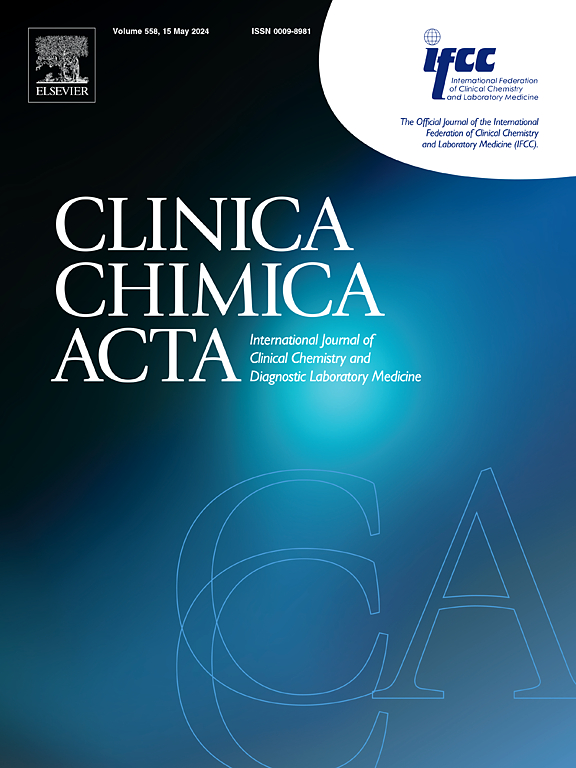基于全血细胞计数的机器学习模型的开发和验证,以预测尿路上皮癌患者的临床结果。
IF 3.2
3区 医学
Q2 MEDICAL LABORATORY TECHNOLOGY
引用次数: 0
摘要
尿路上皮癌(UC)是一种高度恶性疾病,具有重大的公共卫生影响。尽管肿瘤学取得了进步,但早期诊断和有效的预后工具仍然有限。本研究旨在开发一种使用全血细胞计数(CBC)数据的机器学习模型来预测UC患者的临床结果。本研究采用回顾性双中心队列研究,对复旦大学徐汇医院477例UC患者(发现队列)和同济大学普陀人民医院297例UC患者(验证队列)的23个CBC变量进行分析。以总生存期(OS)为主要终点,收集治疗前和治疗后3个月的CBC数据。在发现队列中开发了9个机器学习模型并进行了独立验证。特征选择确定了一个逻辑回归(LR)模型,将白细胞(WBC)计数和淋巴细胞百分比(LYMPH%)作为最佳预测因子。该模型取得了良好的性能,在发现队列中,ROC曲线下面积(AUC)为0.93(95 %CI: 0.90-0.97),精确召回曲线下面积(AUPRC)为0.94(95 %CI: 0.89-0.99),阳性预测值(PPV)为0.87(95 %CI: 0.75-0.98),阴性预测值(NPV)为0.82(95 %CI: 0.78-0.87),准确率为0.83(95 %CI: 0.80-0.88), F1评分为0.82(95 %CI: 0.79-0.86),验证队列中也有类似的结果(AUC 0.88[95 %CI: 0.98])。0.84 - -0.93), 0.81 AUPRC(95 %置信区间:0.75—-0.86),PPV 0.77(95 %置信区间:0.71—-0.84),NPV 0.89(95 %置信区间:0.84—-0.95),精度0.84(95 %置信区间:0.80—-0.89)和F1得分0.80[95 %置信区间:0.74—-0.87])。决策曲线分析显示了一致的净收益,而Kaplan-Meier分析显示,在“预测较差结果”亚组中,OS显著缩短。治疗后,死亡患者白细胞计数增加,淋巴百分比下降,而幸存者则表现出相反的趋势(P本文章由计算机程序翻译,如有差异,请以英文原文为准。
Development and validation of a machine learning model based on complete blood counts to predict clinical outcomes in urothelial carcinoma patients
Urothelial carcinoma (UC) is a highly malignant disease with significant public health implications. Despite advancements in oncology, early diagnosis and effective prognostic tools remain limited. This study aimed to develop a machine learning model using complete blood count (CBC) data to predict clinical outcomes in UC patients. A retrospective, two-center cohort study was conducted, analyzing 23 CBC variables from 477 UC patients at Xuhui Hospital of Fudan University (discovery cohort) and 297 UC patients from Putuo People’s Hospital of Tongji University (validation cohort). CBC data were collected before treatment and three months posttreatment, with overall survival (OS) as the primary endpoint. Nine machine learning models were developed in the discovery cohort and validated independently. Feature selection identified a logistic regression (LR) model incorporating white blood cell (WBC) count and lymphocyte percentage (LYMPH%) as the optimal predictor. The model achieved high performance, with an area under the ROC curve (AUC) of 0.93 (95 %CI: 0.90–0.97), area under the precision-recall curve (AUPRC) of 0.94 (95 %CI: 0.89–0.99), positive predictive value (PPV) of 0.87 (95 %CI: 0.75–0.98), negative predictive value (NPV) of 0.82 (95 %CI: 0.78–0.87), accuracy of 0.83 (95 %CI: 0.80–0.88), and F1 score of 0.82 (95 %CI: 0.79–0.86) in the discovery cohort, and comparable results in the validation cohort (AUC 0.88 [95 %CI: 0.84–0.93], AUPRC 0.81 [95 %CI: 0.75–0.86], PPV 0.77 [95 %CI: 0.71–0.84], NPV 0.89 [95 %CI: 0.84–0.95], accuracy 0.84 [95 %CI: 0.80–0.89], and F1 score 0.80 [95 %CI: 0.74–0.87]). Decision curve analysis demonstrated consistent net benefits, while Kaplan–Meier analysis indicated significantly shorter OS in the “predict worse outcomes” subgroup. Posttreatment, WBC counts increased and LYMPH% decreased in deceased patients, whereas survivors showed the opposite trends (P < 0.05). These findings suggest that a simple, cost-effective CBC-based machine learning model can effectively predict UC prognosis, aiding clinical decision-making.
求助全文
通过发布文献求助,成功后即可免费获取论文全文。
去求助
来源期刊

Clinica Chimica Acta
医学-医学实验技术
CiteScore
10.10
自引率
2.00%
发文量
1268
审稿时长
23 days
期刊介绍:
The Official Journal of the International Federation of Clinical Chemistry and Laboratory Medicine (IFCC)
Clinica Chimica Acta is a high-quality journal which publishes original Research Communications in the field of clinical chemistry and laboratory medicine, defined as the diagnostic application of chemistry, biochemistry, immunochemistry, biochemical aspects of hematology, toxicology, and molecular biology to the study of human disease in body fluids and cells.
The objective of the journal is to publish novel information leading to a better understanding of biological mechanisms of human diseases, their prevention, diagnosis, and patient management. Reports of an applied clinical character are also welcome. Papers concerned with normal metabolic processes or with constituents of normal cells or body fluids, such as reports of experimental or clinical studies in animals, are only considered when they are clearly and directly relevant to human disease. Evaluation of commercial products have a low priority for publication, unless they are novel or represent a technological breakthrough. Studies dealing with effects of drugs and natural products and studies dealing with the redox status in various diseases are not within the journal''s scope. Development and evaluation of novel analytical methodologies where applicable to diagnostic clinical chemistry and laboratory medicine, including point-of-care testing, and topics on laboratory management and informatics will also be considered. Studies focused on emerging diagnostic technologies and (big) data analysis procedures including digitalization, mobile Health, and artificial Intelligence applied to Laboratory Medicine are also of interest.
 求助内容:
求助内容: 应助结果提醒方式:
应助结果提醒方式:


